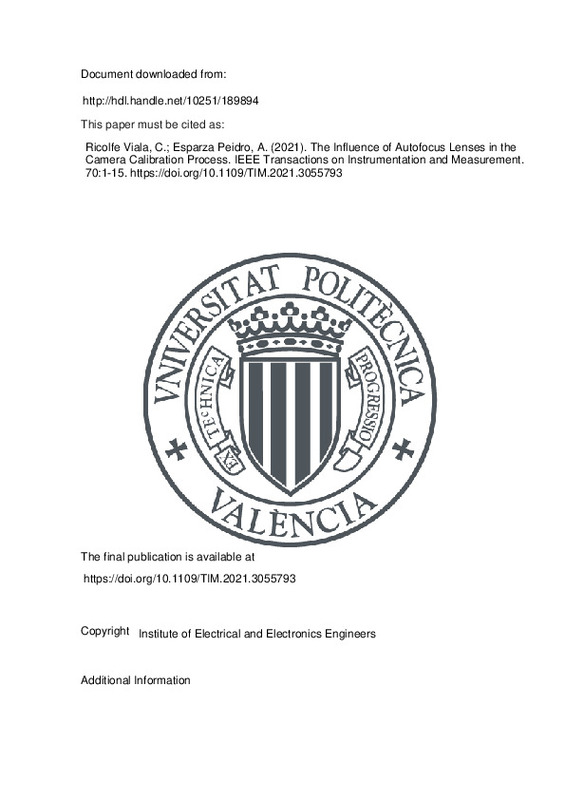JavaScript is disabled for your browser. Some features of this site may not work without it.
Buscar en RiuNet
Listar
Mi cuenta
Estadísticas
Ayuda RiuNet
Admin. UPV
The Influence of Autofocus Lenses in the Camera Calibration Process
Mostrar el registro sencillo del ítem
Ficheros en el ítem
| dc.contributor.author | Ricolfe Viala, Carlos
|
es_ES |
| dc.contributor.author | Esparza Peidro, Alicia
|
es_ES |
| dc.date.accessioned | 2022-11-18T19:01:09Z | |
| dc.date.available | 2022-11-18T19:01:09Z | |
| dc.date.issued | 2021-02-02 | es_ES |
| dc.identifier.issn | 0018-9456 | es_ES |
| dc.identifier.uri | http://hdl.handle.net/10251/189894 | |
| dc.description.abstract | [EN] Camera calibration is a crucial step in robotics and computer vision. Accurate camera parameters are necessary to achieve robust applications. Nowadays, camera calibration process consists of adjusting a set of data to a pin-hole model, assuming that with a reprojection error close to zero, camera parameters are correct. Since all camera parameters are unknown, computed results are considered true. However, the pin-hole model does not represent the camera behavior accurately if the autofocus is considered. Real cameras with autofocus lenses change the focal length slightly to obtain sharp objects in the image, and this feature skews the calibration result if a unique pin-hole model is computed with a constant focal length. In this article, a deep analysis of the camera calibration process is done to detect and strengthen its weaknesses when autofocus lenses are used. To demonstrate that significant errors exist in computed extrinsic parameters, the camera is mounted in a robot arm to know true extrinsic camera parameters with an accuracy under 1 mm. It is also demonstrated that errors in extrinsic camera parameters are compensated with bias in intrinsic camera parameters. Since significant errors exist with autofocus lenses, a modification of the widely accepted camera calibration method using images of a planar template is presented. A pin-hole model with distance-dependent focal length is proposed to improve the calibration process substantially. | es_ES |
| dc.language | Inglés | es_ES |
| dc.publisher | Institute of Electrical and Electronics Engineers | es_ES |
| dc.relation.ispartof | IEEE Transactions on Instrumentation and Measurement | es_ES |
| dc.rights | Reserva de todos los derechos | es_ES |
| dc.subject | 2-D calibration template | es_ES |
| dc.subject | Autofocus lenses | es_ES |
| dc.subject | Camera calibration | es_ES |
| dc.subject | Camera parameters coupling | es_ES |
| dc.subject.classification | INGENIERIA DE SISTEMAS Y AUTOMATICA | es_ES |
| dc.title | The Influence of Autofocus Lenses in the Camera Calibration Process | es_ES |
| dc.type | Artículo | es_ES |
| dc.identifier.doi | 10.1109/TIM.2021.3055793 | es_ES |
| dc.rights.accessRights | Abierto | es_ES |
| dc.contributor.affiliation | Universitat Politècnica de València. Escuela Técnica Superior de Ingeniería del Diseño - Escola Tècnica Superior d'Enginyeria del Disseny | es_ES |
| dc.contributor.affiliation | Universitat Politècnica de València. Escuela Técnica Superior de Ingenieros Industriales - Escola Tècnica Superior d'Enginyers Industrials | es_ES |
| dc.description.bibliographicCitation | Ricolfe Viala, C.; Esparza Peidro, A. (2021). The Influence of Autofocus Lenses in the Camera Calibration Process. IEEE Transactions on Instrumentation and Measurement. 70:1-15. https://doi.org/10.1109/TIM.2021.3055793 | es_ES |
| dc.description.accrualMethod | S | es_ES |
| dc.relation.publisherversion | https://doi.org/10.1109/TIM.2021.3055793 | es_ES |
| dc.description.upvformatpinicio | 1 | es_ES |
| dc.description.upvformatpfin | 15 | es_ES |
| dc.type.version | info:eu-repo/semantics/publishedVersion | es_ES |
| dc.description.volume | 70 | es_ES |
| dc.relation.pasarela | S\434546 | es_ES |







![[Cerrado]](/themes/UPV/images/candado.png)

